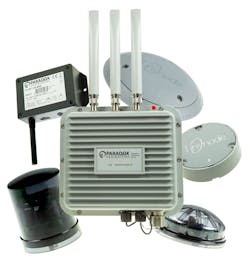Paradox Engineering: Smarter data and service management for truly Open Cities
First launched in 2011, PE Smart Urban Network marked a breakthrough for Smart Cities, offering a single, unified infrastructure to manage both multi-sensor Wireless Internet of Things (IoT) applications such as streetlight management, parking management, smart metering, etc., and Wireless Highspeed IoT services such as pervasive WiFi, video surveillance and other high-bandwidth applications.
The Neptune generation enhances PE Smart Urban Network’s flexibility and interoperability, and enables Open Cities to design and implement a non-proprietary infrastructure to manage multiple services at once, allowing seamless integration of third party systems and devices.
“We’ve always been advocating open standards and interoperability, making them a distinctive feature of our smart IoT solutions”, explained Gianni Minetti, CEO at Paradox Engineering. “With the Neptune generation of PE Smart Urban Network, we are pushing forward a truly unified technology and data model for open wireless environments, and we expect it will accelerate the development of innovative applications for smarter Cities and their communities. In the same spirit, as part of MinebeaMitsumi Group, we have recently joined the uCIFI Alliance to further contribute to the development of open, multi-supplier, interoperable, multi-transport wireless communication solutions for Cities and utilities”.
In addition to interoperability, the Neptune generation of PE Smart Urban Network offers City managers higher efficiency and greater quality in operating key urban services, with improved decision making and quicker return on investment. Leveraging data generated by connected objects and sensors, City managers can reduce power consumption and GHG emissions of streetlights up to 80%, increase parking facilities usage and reduce traffic congestion up to 30%, make Cities more agreeable, liveable and safer, while fostering local economy through the development and delivery of new applications and services.
The Neptune generation of PE Smart Urban Network includes new software and hardware(*):
- PE Smart CMS Neptune, the open and extensible management software platform providing full feature monitoring and control of streetlights, parking lots and any connected IoT device through intuitive web applications;
- PE Smart Lighting Nodes Neptune – NEMA version, supporting 3, 5 and 7-pin NEMA twist-lock sockets. Connected to any existing or new LED streetlight, these IPv6 hardware radio devices allow full remote control of luminaires;
- PE Smart Lighting Nodes Neptune – Zhaga version, acting as IPv6 controllers of luminaire systems and providing a plug-and-play extension module based on standardized DALI2 protocol and specified power supply;
- PE Smart Gateway Neptune, natively managing IPv6 and IPv4 network technologies, operating as device and network coordinator, and data concentrator of the wireless mesh PE Smart Urban Network.
All Neptune generation grants outstanding protection by supporting advanced security modules (crypto engines) on hardware devices, dedicated user roles and fully secured data flows on PE Smart CMS, and blockchain-based data security.
Both software and hardware allow easy upgrade and expansion, with effortless integration of existing or new devices and third-party systems. Auto-commissioning processes are provided to detect additional devices and connect them to the self-configuring and self-healing network.
PE Smart CMS Neptune: the feature-rich solution for Open City management
PE Smart CMS Neptune is the open management platform for secure urban networks, supporting from a few up to hundreds of thousands of connected objects. It provides City operators with a unique and reliable software to manage device connectivity, data transport, processing, storing and analysis, as well as data presentation through an intuitive user interface.
The Neptune generation of PE Smart CMS has been improved to offer outstanding extensibility and interoperability thanks to the standard-based data model and the possibility to easily add new applications, device types and attributes. The multitenancy architecture allows to host multiple Customers on a single cloud-based server, providing adequate data segregation and load balancing.
Unparalleled scalability and modularity are granted through the microservices-based backend architecture, APIs covering 100% of feature set and the enhanced frontend. City operators will appreciate its superior performance, as system response time is fully independent of network size, as well as the improved data and application protection, pioneering blockchain technology for over the edge data security.
“Together with Paradox Engineering, we started to develop a smart network in Massagno back in 2017. With PE Smart CMS Neptune we now have an improved, more flexible, intuitive and robust management system, supporting us in the growth of our urban infrastructure for present and future needs”, stated Paolo Rossi, director at AEM SA, the Swiss energy provider among the first to pilot PE Smart CMS Neptune. “We have been serving Massagno and surroundings for more than 90 years, looking after the continuity and quality of power supply, as well as the development of the region and the well-being of its communities. The Smart Urban Network is boosting the efficiency and quality of our services, and enabling the innovation of Ticino Canton in the medium-long run”.
Key features of PE Smart CMS Neptune include accurate network management and device control to monitor and manage all connected objects, setting key parameters, triggering immediate actions or defining command schedules for single or grouped devices (ie. switching lights on/off or adjust dimming levels, execute lighting patterns in a given combination of day/time, along given luminance values, or upon vehicle transit).
Reliable event management features are provided to easily and accurately track status information of connected objects, receiving warnings and alarms anytime an anomaly is detected. The solution allows efficient network commissioning through a set of vertical applications including inventory and asset management, Over-the-Air firmware and script updates. Thanks to advanced reporting and analytics, City operators can generate customized and actionable reports for single or grouped devices.
PE Smart CMS Neptune offers an easy and friendly user experience. It can be accessed through an intuitive web application, designed to grant a low response time and a fluid control over devices and data, with multiple personalization options.
The Software Development Kit (SDK) allows authorized software developers to independently add features and applications to PE Smart CMS, accelerating their go-to-market plans by leveraging existing software components, as well as the open data model. Available from the second half of 2019, an Application Store will provide SDK developers with the opportunity to publish and share their own vertical applications.
Important note:
(*) PE Smart CMS Neptune is immediately available to customers and partners. PE Smart Lighting Nodes Neptune (NEMA and Zhaga), as well as PE Smart Gateway Neptune, will be released throughout the second half of 2019. Pricing and sales will be managed by MinebeaMitsumi Group commercial affiliates.
The platform includes current Tinynode’s wireless vehicle detection sensors for parking-related applications. Neptune generation of parking sensors will be announced later in 2019.





